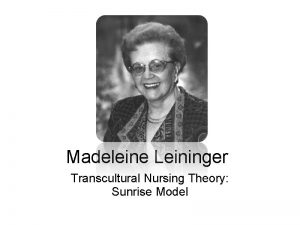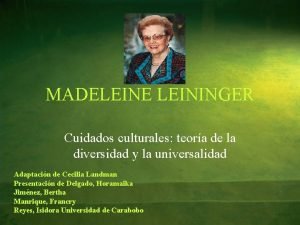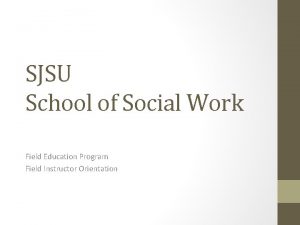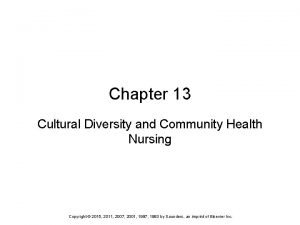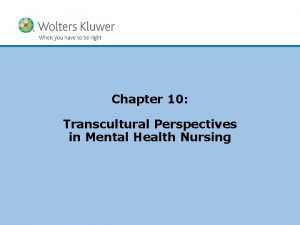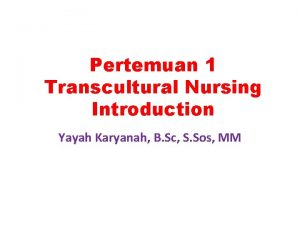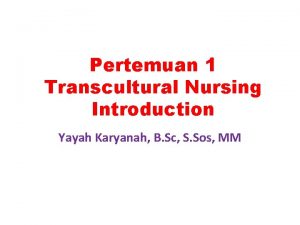Chapter 5 Transcultural Nursing in the Community Copyright




















- Slides: 20

Chapter 5 Transcultural Nursing in the Community Copyright © 2010 Wolters Kluwer Health | Lippincott Williams & Wilkins

The Meaning of Culture • Beliefs, values, and behavior shared by members of a society; they provide a design or roadmap for living • “The acquired knowledge that people use to generate behavior and interpret experience” (Spradley & Mc. Curdy, 2005) • “A patterned behavioral response that develops over time as a result of imprinting the mind through social and religious structures and intellectual and artistic manifestations” (Giger & Davidhizar, 2002) Copyright © 2010 Wolters Kluwer Health | Lippincott Williams & Wilkins

Other Key Terms • Race: biologically designated groups of people whose distinguishing features, such as skin color, are inherited • Ethnic group: collection of people who have common origins and a shared culture and identity; they may share a common geographic origin, race, language, religion, traditions, values, and food preferences (Spector, 2004) • Ethnicity: group of qualities that mark his or her association with a particular ethnic group or “who share cultural and/or physical characteristics including one or more of the following: history, political system, religion, language, geographical origin, traditions, myths, behaviors, foods, genetic similarities, and physical features (Ethnicity Online, 2007) Copyright © 2010 Wolters Kluwer Health | Lippincott Williams & Wilkins

Other Key Terms (cont. ) • Cultural diversity (cultural plurality): variety of cultural patterns coexisting within a designated geographic area • Subcultures: relatively large aggregates of people within a society sharing separate distinguishing characteristics • Microcultures: smaller groups within a subculture • Ethnocentrism: belief or feeling that one’s own culture is best • Ethnorelativism: seeing all behavior in a cultural context Copyright © 2010 Wolters Kluwer Health | Lippincott Williams & Wilkins

Question Is the following statement true or false? • “Race” and “ethnicity” are interchangeable terms. Copyright © 2010 Wolters Kluwer Health | Lippincott Williams & Wilkins

Answer • False – Race refers to biologically designated groups of people whose distinguishing features are inherited. Ethnicity refers to a group of qualities that mark a person’s association with a particular ethnic group or a group that shares cultural and/or physical characteristics. Copyright © 2010 Wolters Kluwer Health | Lippincott Williams & Wilkins

Copyright © 2010 Wolters Kluwer Health | Lippincott Williams & Wilkins

Characteristics of Culture • Learned • Integrated • Shared • Mostly tacit • Dynamic Copyright © 2010 Wolters Kluwer Health | Lippincott Williams & Wilkins

Ethnocultural Health Practices • World community – Biomedical view – Magicoreligious view – Holistic view – Folk medicine and home remedies – Herbalism – Prescription and over-the-counter drugs Copyright © 2010 Wolters Kluwer Health | Lippincott Williams & Wilkins

Ethnocultural Health Practices (cont. ) • Complementary therapies and self-care practices – Diet therapies (cancer diets, juice diets, fasting) – Gastrointestinal treatments (coffee enemas, high colonic enemas) – Balance and exercise activities (t’ai chi, yoga) – Sensory exposure (aromatherapy, music therapy, light therapy) – Therapeutic manipulation (acupuncture, acupressure, reflexology) Copyright © 2010 Wolters Kluwer Health | Lippincott Williams & Wilkins

Role of the Community Health Nurse • Preparation – Cultural awareness (see Display 5. 3) – Sensitivity • Assessment (use of appropriate tools; see Tables 5. 7 and 5. 8) • Teaching Copyright © 2010 Wolters Kluwer Health | Lippincott Williams & Wilkins

Question Which of the following would describe a culture? a. Inherited b. Static c. Individualized d. Tacit Copyright © 2010 Wolters Kluwer Health | Lippincott Williams & Wilkins

Answer d. Tacit • Culture is learned, integrated, shared, mostly tacit, and dynamic. Copyright © 2010 Wolters Kluwer Health | Lippincott Williams & Wilkins

Selected Cultural Communities • Native American Indians, Aleut, and Eskimo communities – Population characteristics and culture – Health problems – Health beliefs and practices • Blacks or African Americans – Population characteristics and culture – Health problems – Health beliefs and practices Copyright © 2010 Wolters Kluwer Health | Lippincott Williams & Wilkins

Selected Cultural Communities (cont. ) • Asian Americans – Population characteristics and culture – Health problems – Health beliefs and practices • Hispanic Americans – Population characteristics and culture – Health problems – Health beliefs and practices Copyright © 2010 Wolters Kluwer Health | Lippincott Williams & Wilkins

Selected Cultural Communities (cont. ) • Arab populations and Muslims – Population characteristics and culture – Health problems – Health beliefs and practices Copyright © 2010 Wolters Kluwer Health | Lippincott Williams & Wilkins

Transcultural Nursing Principles • Develop cultural self-awareness. • Cultivate cultural sensitivity. • Assess the client group’s culture. • Show respect and patience while learning about other cultures. • Examine culturally derived health practices. Copyright © 2010 Wolters Kluwer Health | Lippincott Williams & Wilkins

Internet Resources • Office of Minority Health: http: //www. omhrc. gov/omhrc/ • U. S. Census: http: //www. census. gov • Immigration Assistance Section: http: //theodora. com • Culture and Diversity Section: http: //www. amsa. org • Kaiser Family Foundation: http: //www. kff. org • Multicultural Health Communication Service: http: //www. mhcs. health. nsw. gov. au/ • Asian & Pacific Health: http: //www. aapcho. org Copyright © 2010 Wolters Kluwer Health | Lippincott Williams & Wilkins

Question Is the following statement true or false? • The first step of applying transcultural nursing principles is to cultivate cultural sensitivity. Copyright © 2010 Wolters Kluwer Health | Lippincott Williams & Wilkins

Answer • False – The nurse should first develop cultural selfawareness and then cultivate cultural sensitivity. Copyright © 2010 Wolters Kluwer Health | Lippincott Williams & Wilkins
 Sunrise model transcultural nursing
Sunrise model transcultural nursing Transcultural nursing questions
Transcultural nursing questions Patricia enciso
Patricia enciso Theoretical foundation of nursing chapter 1
Theoretical foundation of nursing chapter 1 Madeleine leininger teoria transcultural
Madeleine leininger teoria transcultural Towards a theory of transcultural fandom
Towards a theory of transcultural fandom Sjsu social work
Sjsu social work Giger and davidhizar transcultural assessment model
Giger and davidhizar transcultural assessment model Transcultural health care
Transcultural health care Transcultural health care definition
Transcultural health care definition Culturological assessment
Culturological assessment Hình ảnh bộ gõ cơ thể búng tay
Hình ảnh bộ gõ cơ thể búng tay Ng-html
Ng-html Bổ thể
Bổ thể Tỉ lệ cơ thể trẻ em
Tỉ lệ cơ thể trẻ em Gấu đi như thế nào
Gấu đi như thế nào Chụp phim tư thế worms-breton
Chụp phim tư thế worms-breton Hát lên người ơi
Hát lên người ơi Các môn thể thao bắt đầu bằng tiếng chạy
Các môn thể thao bắt đầu bằng tiếng chạy Thế nào là hệ số cao nhất
Thế nào là hệ số cao nhất Các châu lục và đại dương trên thế giới
Các châu lục và đại dương trên thế giới
